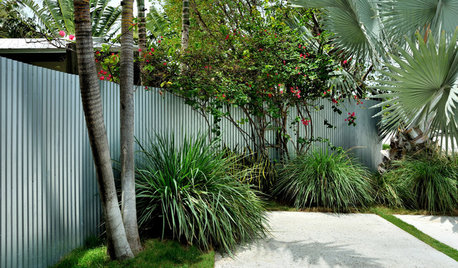Excess Zinc and Boron
peter_6
14 years ago
Featured Answer
Sort by:Oldest
Comments (42)
gardengal48 (PNW Z8/9)
14 years agodchall_san_antonio
14 years agoRelated Discussions
Root crop and boron
Comments (1)If your soil is low in boron and only a soil test can tell you, It might help. An excess of boron is very detrimental however, so use extreme caution when using Borax. A soluble fertizer that contains the trace nutrients may be more appropriate. Usually, radishes not forming is due to 1. high soil temperature and 2. overcrowding....See MoreBoron Spray or Soil Application
Comments (15)Stick with a foliar application after getting a leaf analysis done to see if you need anything. It looks to me like your soil test is reflective of adding large quantities of manure--most nutrients are very high, and many nutrients can act as substitutes. High levels of one nutrient can result in a deficiency of another in the plant, not because the nutrient is lacking but because another is present in such high levels that the plant takes it up in excess instead, leaving a deficiency. I've had personal experience with this in my garden. After applying large quantities of manure for several years, my soil tests showed nutrient levels were all very high, my pH came down a few tenths (mid 7's instead of high 7's to low 8's), and I started developing symptoms of zinc deficiency even though the soil test showed it was "very high" in the soil. A shot of foliar zinc cleared up the problem and I backed off on the manure. After that, my salt levels declined dramatically, also. Your soil calcium levels are good and the boron levels are right where you want them, so any deficiency is probably due to an uptake problem. As said, boron can become very toxic very quickly. I would never add boron to the soil at a rate higher than 2 lbs/acre because of the risk of getting too much--at a presence of 4lbs/ac. in the soil, you would be killing it. Manure tends to be very high in salts from the urine and your sodium levels are fairly high. You should continue to hold off on manure applications for a few years and make sure the soil is well watered when watered to help wash the sodium out through natural drainage. All the organics you added will decay over time and you will need to add soil or additional organic matter (leaves, grass clippings, compost, etc) to keep the soil level up. If you continually add a lot of organics, the organic component of the soil will increase due to the higher supply. If you stop, it will decrease over time to natural levels based on how much vegetative matter normally falls on or grows in the soil. Natural topsoil will run from a few inches to several feet thick. Under that, you get a mineral soil based on what nature provided. I wouldn't worry about a yellowish sand several feet down. The plants are getting most of their nutrients from the top foot, and the sand may help provide drainage....See MoreLow boron
Comments (13)Another thing to consider is the fact that many of the water sources (municipal and well) all up and down the west coast contain plenty of boron to satisfy plant nutritional requirements for that element. If you've got more than 0.3 ppm boron in the irrigation water, you won't have to add any. Think "liquid feed program". This is especially true in a heavy soil. 3 ppm is the desired level, according to his paradigm. All tests I have seen have been well below 1 ppm. Make sure you know what analytical method you're dealing with when using that number. 3 ppm extractable boron via Meilich 3, DTPA or other extraction may be fine. 3 ppm soluble boron via saturation extract (which is a very common way to measure boron) would burn a broad range of stuff. In saturation extract, boron should be less than 1 ppm for most stuff and less than 0.8 for sensitive plants. About 0.12 ppm in the soil would be sufficient for most plants....See Morehelp interperting soil test results. excess calcium and potassium
Comments (12)the weeds that I have won't be slowed down at all by weed cloth or cardboard. I have tried both in the past. Tried even commercial weed cloth. Using something like rubber or tin is the ONLY way to keep this highly invasive grass from consuming the entire beds. The grass would grow up from the bottom and take over the whole bed within two years time. This stuff is BAD. so far, it seems that they are draining fine. We have had some pretty heavy rains and I dug down into the beds and found nice moist loose soil. No packed mud, no pooling. This is going to have to work. There is no option. one year I set up an above ground pool, with a ground cloth under it. Within two months, the nut grass grew thru the bottom of the pool. if you have never had to deal with these two weeds you just can't imagine how invasive and resilient they are....See Morepeter_6
14 years agoKimmsr
14 years agopeter_6
14 years agoDan _Staley (5b Sunset 2B AHS 7)
14 years agoKimmsr
14 years agoDan _Staley (5b Sunset 2B AHS 7)
14 years agoKimmsr
14 years agoDan _Staley (5b Sunset 2B AHS 7)
14 years agogardengal48 (PNW Z8/9)
14 years agopeter_6
14 years agoDan _Staley (5b Sunset 2B AHS 7)
14 years agoorganicdan
14 years agonovice_2009
14 years agoKimmsr
14 years agogardengal48 (PNW Z8/9)
14 years agoDan _Staley (5b Sunset 2B AHS 7)
14 years agogargwarb
14 years agoDan _Staley (5b Sunset 2B AHS 7)
14 years agogargwarb
14 years agoDan _Staley (5b Sunset 2B AHS 7)
14 years agopeter_6
14 years agoorganicdan
14 years agopeter_6
14 years agoorganicdan
14 years agomaifleur01
14 years agogargwarb
14 years agogargwarb
14 years agopeter_6
14 years agopagardner
14 years agogargwarb
14 years agopeter_6
14 years agonovice_2009
14 years agogargwarb
14 years agopeter_6
14 years agogargwarb
14 years agopnbrown
13 years agoMichael
13 years agopeter_6
13 years agojolj
13 years ago
Related Stories

ARCHITECTUREDesign Workshop: Getting a Feel for Steel
Versatile and strong beyond belief, steel can create amazing expressions in homes and landscapes
Full Story
EARTH DAYGrow a Beautiful Garden With Ecofriendly Greywater
Reducing home water waste means lower bills and a healthier planet. Here's how to set up a greywater home irrigation system that can help
Full Story
KITCHEN COUNTERTOPSKitchen Countertop Materials: 5 More Great Alternatives to Granite
Get a delightfully different look for your kitchen counters with lesser-known materials for a wide range of budgets
Full Story
MATERIALSHumble Corrugated Metal Brings Modern Style to the Garden
This sustainable material is not just for rooftops. See these ideas for using it for fences, beds and rain barrels in your yard
Full Story
REMODELING GUIDESMaterials: The Advantages of a Metal Roof
Metal reigns in roofing style, maintenance and energy efficiency
Full Story
RUSTIC STYLEKitchen of the Week: Found Objects and Old Italian Farmhouse Charm
A homeowner and her cabinetmaker create a personal version of European-inspired comfort and simplicity
Full Story
KITCHEN COUNTERTOPS7 Low-Maintenance Countertops for Your Dream Kitchen
Fingerprints, stains, resealing requirements ... who needs ’em? These countertop materials look great with little effort
Full Story
CONCRETEWhy Concrete Wants to Crack
We look at the reasons concrete has a tendency to crack — and what you can do to help control it
Full Story
GREEN BUILDINGOff the Grid: Ready to Pull the Plug on City Power?
What to consider if you want to stop relying on public utilities — or just have a more energy-efficient home
Full Story
GREEN BUILDINGEcofriendly Cool: Insulate With Wool, Cork, Old Denim and More
Learn about the pros and cons of healthier alternatives to fiberglass and foam, and when to consider an insulation switch
Full Story




organicdan